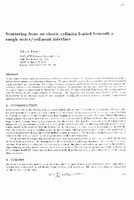| dc.contributor.author | Fawcett, John A. | |
| dc.date.accessioned | 2018-10-11T14:08:10Z | |
| dc.date.available | 2018-10-11T14:08:10Z | |
| dc.date.issued | 1997 | |
| dc.identifier | 11454 | |
| dc.identifier.govdoc | CP-45 | |
| dc.identifier.uri | http://hdl.handle.net/20.500.12489/414 | |
| dc.description.abstract | In this paper a plane-wave decomposition method is used to compute the two-dimensional backscattering from a buried elastic cylinder as a function of frequency. The cases of a pat water/sediment interface and deteministically rough interfaces are considered. For rough interfaces, first-order perturbation theory is utilized to compute the interface reflection and transmission scatiering matrices. In particular, the situation where the grazing angle in the water column is sub-critical is considered. In this case, at suficiently high frequencies, the energy scattered into the bottom by the rough interface is dominant. The amplitude and spectral characteristics of the energy backscattered by the in.terface itself are also computed. Finally, the accuracy of using a sim,pler, single-scatter approximation is examined. | |
| dc.format | 8 p. : ill. ; digital, PDF file | |
| dc.language | English | |
| dc.publisher | NATO. SACLANTCEN | |
| dc.source | In: High Frequency Seafloor Acoustics (SACLANTCEN Conference Proceedings CP-45), 1997, pp. 147-154 | |
| dc.subject | Acoustic scattering by elastic structures | |
| dc.subject | Shells (Engineering) | |
| dc.subject | Buried objects detection | |
| dc.subject | Mine burial and bottom conditions | |
| dc.title | Scattering from an elastic cylinder buried beneath a rough water/sediment interface | |
| dc.type | Papers and Articles | |
| dc.type | Conference Proceedings (CP) | |
